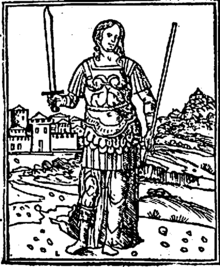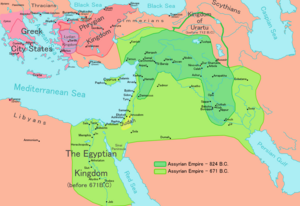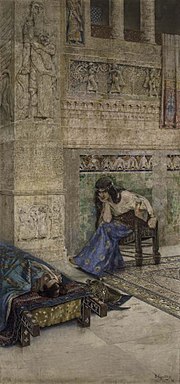Semiramis

Semiramis(/səˈmɪrəmɪs,sɪ-,sɛ-/;[1]Syriac:ܫܲܡܝܼܪܵܡŠammīrām,Armenian:ՇամիրամŠamiram,Greek:Σεμίραμις,Arabic:سميراميسSamīrāmīs) was the legendary[2][3]Lydian-Babylonian[4][5]wife ofOnnesand ofNinus,who succeeded the latter on the throne ofAssyria,[6]according toMovses Khorenatsi.[7]Legends narrated byDiodorus Siculus,who drew primarily from the works ofCtesias of Cnidus,[8][9]describe her and her relationships to Onnes and King Ninus.
Armeniansand theAssyriansofIraq,northeastSyria,southeastTurkey,and northwestIranstill useShamiramas a given name for girls.[10]
The real and historicalShammuramat,the originalAkkadianform of the name, was the Assyrian wife ofShamshi-Adad V(ruled 824 BC–811 BC). She ruled theNeo-Assyrian Empireas its regent for five years, before her sonAdad-nirari IIIcame of age and took the reins of power.[11]She ruled at a time of political uncertainty, which may partly explain why Assyrians may have accepted the rule of a woman when it was not allowed by their cultural tradition. She conquered much of the Middle East and theLevantand stabilized and strengthened the empire after a destructive civil war. It has been speculated that being a woman who ruled successfully may have made the Assyrians regard her with particular reverence and that her achievements may have been retold over the generations until she was gradually turned into a legendary figure.[12]
The name of Semiramis came to be applied to variousmonumentsin Western Asia and Anatolia whose origins had been forgotten or unknown,[13]even theBehistun InscriptionofDarius.[14][15]Herodotusascribes to her the artificial banks that confined theEuphrates.[16]He knew her name because it was inscribed on a gate of Babylon.[17]Various places inMesopotamia,Media,Persia,theLevant,Anatolia,the Arabian Peninsula, and theCaucasusreceived names recalling Semiramis.
Historical figure[edit]

While the achievements of Semiramis are clearly in the realm of mythical Persian, Armenian, and Greek historiography, the historical Shammuramat certainly existed. After her husband's death, she might have served as regent for her son,Adad-nirari III.[11]Thus, during that time Shammuramat could have been in control of the vast Neo-Assyrian Empire (911–605 BC), which stretched from theCaucasus Mountainsin the north to the Arabian Peninsula in the south, and from westernIranin the east toCyprusin the west.[12]
In the city ofAššuron theTigris,she had an obelisk built and inscribed that read, "Stele of Shammuramat, queen ofShamshi-Adad,King of the Universe, King of Assyria, Mother of Adad Nirari, King of the Universe, King of Assyria, Daughter-in-Law ofShalmaneser,King of the Four Regions of the World."[12]
Legend according to Diodorus Siculus[edit]
This sectionneeds additional citations forverification.(July 2017) |

According toDiodorus,a first century BC Greek historian, Semiramis was of noble parents, the daughter of the fish-goddessDerketoofAscalonand of a mortal. He related that Derketo abandoned her at birth and drowned herself.Dovesfed the child until Simmas, the royal shepherd, found her. Semiramis marriedOnnesor Menones, a general under KingNinus,and she became an advisor to the king. Her advice led him to great successes. At the Siege of Bactra, she personally led a party of soldiers to seize a key defensive point, leading to the capture of the city.[12][18]
Ninus was so struck that he fell in love with her. He tried to compel Onnes to give her to him as a wife, first offering his own daughter Sonanê in return and eventually threatening to put out his eyes as punishment. Out of fear of the king, and out of doomed passion for his wife, Onnes "fell into a kind of frenzy and madness" and hanged himself. Ninus then married Semiramis.[12][19]
Diodorus relates that after their marriage, Semiramis and Ninus had a son named Ninyas. After King Ninus conquered Asia, including theBactrians,he[who?]was fatally wounded by an arrow. Semiramis disguised herself as her son so the army would follow her instructions, thinking they came from their new ruler. Diodorus writes that her reign lasted for 42 years and that she conquered much of Asia and achieved many feats. She restored ancientBabylonand protected it with a high brick wall that completely surrounded the city. She built several palaces in Persia, includingEcbatana.[20]
She ruled Asia effectively and addedLibyaandAethiopiato the empire. She went to war with King Stabrobates (Supratika) ofIndia,having her artisans build an army of false elephants by putting manipulated skins of dark-skinned buffaloes over her camels to deceive the Indians into thinking she had acquired real elephants. This ploy succeeded initially, but she was wounded in the counterattack and her army mainly annihilated, forcing the surviving remnants to re-ford the Indus and retreat to the west.[21]
Diodorus mistakenly attributed theBehistun Inscriptionto her; it is now known to have been produced byDarius the Great.[22][23][24]The writings of Diodorus about Semiramis are strongly influenced by the writings ofCtesias of Cnidus,although his writings about Semiramis do not always follow those by Ctesias.[25]
Other ancient traditions[edit]
Legends describing Semiramis have been recorded by approximately 80 ancient writers includingPlutarch,Eusebius,Polyaenus,Valerius Maximus,Orosius,andJustinus.[26]She was associated withIshtarandAstartesince the time before Diodorus.[12]The association of the fish and dove is found at Hierapolis Bambyce (Mabbog,nowManbij), the great temple that according to one legend, was founded by Semiramis,[27]where her statue was shown with a golden dove on her head.[28]
The name of Semiramis came to be applied to variousmonumentsin Western Asia and Anatolia, the origins of which ancient writers sometimes asserted had been forgotten or unknown.[13]Various places inAssyriaand throughoutMesopotamiaas a whole,Media,Persia,theLevant,Anatolia, the Arabian Peninsula, and theCaucasusbore the name of Semiramis in slightly changed forms, even some named during theMiddle Ages.She is credited with founding the city ofVanin Turkey in order to have a summer residence and that city may be found referred to asShamiramagerd(city of Semiramis).[29]

Herodotus,an ancient Greek writer, geographer, and historian living fromc.484 to 425 BC, ascribes to Semiramis the artificial banks that confined the Euphrates[16]and knows her name as borne by a gate of Babylon.[17]Strabo,a Greek geographer, philosopher, and historian who lived inAsia Minorduring 64 or 63 BC to 24 AD, credits her with building earthworks and other structures "throughout almost the whole continent".[30]Nearly every stupendous work of antiquity by theEuphratesor in Iran seems to have been ascribed to Semiramis, even theBehistun InscriptionofDarius.[14][15]
Roman historianAmmianus Marcellinus(c. 330– c. 400), who wrote the penultimate major historical account surviving from antiquity, credits her as the first person tocastratea male youth intoeunuch-hood: "Semiramis, that ancient queen who was the first person to castrate male youths of tender age".[31]
Armeniantradition portrays Semiramis negatively, possibly because of a victorious military campaign she waged against them.[12]One of the most popular legends in Armenian tradition involves Semiramis and an Armenian king,Ara the Handsome.According to that legend, Semiramis had fallen in love with the handsome Armenian King Ara and asked him to marry her. When he refused, in her passion she gathered the armies of Assyria and marched against Armenia.[32][29]
During the battle Semiramis was victorious, but Ara was slain despite her orders to capture him alive. This legend continues that to avoid continuous warfare with the Armenians, Semiramis, who they alleged was a sorceress, took his body and prayed to deities to raise Ara from the dead. When the Armenians advanced to avenge their leader, she disguised one of her lovers as Ara and spread the rumor that the deities had brought Ara back to life, reportedly, convincing the Armenians not to continue the war.[32][29]
In one persistent tradition in this vein, the prayers of Semiramis are successful and Ara returns to life.[32][33]During the nineteenth century, it was reported that a village called Lezk, nearVanin Turkey, traditionally held that it was the location of the resurrection of Ara.[32]
In later traditions[edit]
She is Semiramis, of whom we read
That she succeeded Ninus, and was his spouse;
She held the land which now the Sultan rules.”
—Dante'sDivine Comedy,Canto V, lines 60 to 62
Although negative portrayals did exist, generally, Semiramis was viewed positively before the rise ofChristianity.[12][34]During the Middle Ages, she became associated with promiscuity and lustfulness. One story claimed that she had an incestuous relationship with her son, justified it by passing a law to legitimize parent-child marriages, and invented thechastity beltto deter any romantic rivals before he eventually killed her.[35][36]This was likely popularized in the fifth century byOrosiusin his universal history,Seven Books of History Against the Pagans,which has been described as an "anti-pagan polemic".[35][37]
In theDivine Comedy(InfernoV), Dante places Semiramis among the souls of the lustful in the Second Circle ofHell.She appears inPetrarch'sTriumph of Love(canto III, verse 76). She is one of three women exemplifying "evil love", the other two beingByblisandMyrrha.She is included inDe Mulieribus Claris,a collection of biographies of historical and mythological women by theFlorentineauthorGiovanni Boccacciothat was composed in 1361–1362. It is notable as the first collection devoted exclusively to biographies of women in Western literature.[38]Semiramis always was admired for her martial and political achievements.
Her reputation partly recovered in the late Middle Ages and Renaissance. She was included inChristine de Pizan'sThe Book of the City of Ladies,finished by 1405, and, starting in the fourteenth century, she was commonly found on theNine Worthies list for women.[35][36]
Literary references[edit]
Semiramis appears in many plays, such asVoltaire's tragedySémiramisandPedro Calderón de la Barca's dramaLa hija del aire,and in operas by dozens of composers[39]includingAntonio Vivaldi,Christoph Willibald Gluck,Domenico Cimarosa,Josef Mysliveček,Giacomo Meyerbeer,andGioachino Rossini.Arthur Honeggercomposed music forPaul Valéry's 1934 "ballet-pantomime"Semiramis,which was revived in 1992 after many years of neglect.
InEugène Ionesco's playThe Chairs,the Old Woman character is referred to as Semiramis. It has been suggested[by whom?]that the poemSemiramis,perhaps written in 1017 byWarner of Rouenat the court ofEmma of Normandy'sbrother,Richard, Duke of Normandy,and dedicated to her brother, ArchbishopRobert,was a satire ridiculing Emma's relation with her husband KingCnut.[clarification needed]

Semiramis was mentioned byWilliam ShakespeareinTitus Andronicus(II.1) andThe Taming of the Shrew(Ind.2). Portrayal of Semiramis has been used as a metaphor for female rulership. Sometimes she was referenced during political disputes regarding rule by women, both as an unfavorable comparison, for example, againstElizabeth I of England,and as an example of a woman who governed well.[34]Powerful female monarchsMargaret I of DenmarkandCatherine the Greatwere given the designationSemiramis of the North.[40][41]
The mother of the sultan in "The Man of Law's Tale"inGeoffrey Chaucer'sCanterbury Talesis compared to Semiramis, with the intention of suggesting that the mother of the sultan is an evil woman just like Semiramis.
In the twentieth century, Semiramis has appeared in severalsword and sandalfilms. She was portrayed byRhonda FleminginQueen of Babylon(1954) and byYvonne FurneauxinI am Semiramis(1963).
The Two Babylons[edit]
Despite a lack of supporting evidence in the Bible, the bookThe Two Babylons(1853), by the Christian ministerAlexander Hislop,was particularly influential in characterizing Semiramis as theWhore of Babylon.[12]Hislop claimed that Semiramis inventedpolytheismand, with it,goddess worship.[42]He claimed that the head of theCatholic Churchinherited and continued to propagate a millennia-old secretconspiracy,founded by Semiramis and the Biblical kingNimrod,to propagate thepaganreligion of ancientBabylon.[43]Grabbe and others have rejected the allegations in this book as based on a flawed understanding of the texts,[43]but variations of them are accepted among some[which?]groups ofevangelicalProtestants.[43]
Hislop asserted that Semiramis was aqueen consortand the mother ofNimrod,builder of the Bible'sTower of Babel.He said that Semiramis and Nimrod's incestuous male offspring was the Akkadian deityTammuz,and that all divine pairings in religions were retellings of this story.[43]These claims are still circulated among some groups of evangelical Protestants,[43]in the form ofJack Chicktracts,[44]comic books,and related media.
Critics have dismissed the speculations by Hislop as based on misunderstandings.[43][45]
Lester L. Grabbehas claimed that Hislop's argument, particularly his identification of Ninus withNimrod,is based on a misunderstanding of historical Babylon and its religion.[43]Grabbe criticized Hislop for portraying Semiramis as Nimrod's consort, despite that she has not been found in a single text associated with him,[43]and for portraying her as the "mother of harlots", even though this is not how she is depicted in any of the historical texts where she is mentioned.[43]
Ralph Woodrowalso has been critical of this interpretation and has stated that Alexander Hislop "picked, chose and mixed" portions of various myths from different cultures.[46]
In modern culture[edit]
- TheSemiramis InterContinental HotelinCairois named after her. It is where theCairo Conference of 1921took place and was presided over byWinston Churchill.[47]
- Semiramis appears in the Japanese light novel and anime seriesFate/Apocryphaof theFatefranchise as the Assassin of Red. She also appears in the mobile game of the same franchise,Fate/Grand Order.
- Semiramisis an Italian progressive rock band who produced one LP,Dedicato a Frazz(1973).
- Semiramis is mentioned in theMalice Mizersong "Illuminati"(1998).[relevant?]
- InJohn Myers Myers' 1949 novelSilverlock,Semiramis appears as a lustful, commanding queen, who stops her procession to try to seduce young Lucius, who has been transformed into a donkey.[48]
- Christopher C. Doyle'sThe Secret of the Druids(2017), the third book in theMahabharata Secrettrilogy, depicts Semiramis as the estranged daughter of powerful Indian king Sthabarpati, who attacks her father's kingdom in pursuit ofamrita(nectar). When she learns her son has conspired against her, she abdicates her throne and moves to Ireland, where she is revered as a goddess.
See also[edit]
References[edit]
- ^Wells, John C. (2008),Longman Pronunciation Dictionary(3rd ed.), Longman,ISBN9781405881180
- ^Robin Lane Fox (4 September 2008).Travelling Heroes: Greeks and their myths in the epic age of Homer.Penguin UK.ISBN978-0-14-188986-3.OCLC1004570108.
Semiramis was an invention of the Greek legend only
- ^Kühne, Hartmut (2008)."Sexgender, Power And Sammuramat: A View From The Syrian Steppe".Fundstellen: gesammelte Schriften zur Ärchäologie und Geschichte Altvorderasiens; ad honorem Hartmut Kühne.Otto Harrassowitz Verlag. p. 352.ISBN978-3-447-05770-7.
- ^Creighton M.A. L.L.D., Rev. Mandell (1888).The Historical Review.Vol. 3. London & New York: Longmans, Green, And Co. p. 112.
- ^Yehoshua, Avram (June 7, 2011).The Lifting of the Veil: Acts 15:20-21.Trafford Publishing. p. 58.ISBN978-1426972034.
- ^Bernbeck 2008,p. 353.
- ^Moses (of Khoren) (2006).History of the Armenians.Caravan Books.ISBN978-0-88206-111-5.OCLC1011412893.
- ^Diodorus Siculus: The Library of History, Book II, Chapters 1-22
- ^Muntz, Charles Edward (2017).Diodorus Siculus and the world of the late Roman republic.New York, NY: Oxford University Press. p. 23.ISBN9780190498726.
- ^"Assyrian Names and Meanings for Boys and Girls".atour.Retrieved2020-08-24.
- ^ab"Sammu-ramat (queen of Assyria)".Britannica Online Encyclopedia.Retrieved2013-01-04.
- ^abcdefghi"Sammu-Ramat and Semiramis: The Inspiration and the Myth".World History Encyclopedia.Retrieved2016-04-13.
- ^abSeeStraboxvi. I. 2
- ^abDiodorus Siculus ii. 3
- ^abReade, Julian (2000). "Alexander the Great and the Hanging Gardens of Babylon".Iraq.62:195–217.doi:10.2307/4200490.ISSN0021-0889.JSTOR4200490.S2CID194130782.
- ^abi. 184
- ^abiii. 155
- ^The Library of History by Diodorus Siculus,Vol. 1, The Loeb Classical Library, 1933. Retrieved on 2015-03-08 fromhttp://penelope.uchicago.edu/Thayer/E/Roman/Texts/Diodorus_Siculus/2A*.html.
- ^The Library of History by Diodorus Siculus,Vol. 1, The Loeb Classical Library, 1933. Retrieved on 2015-03-08 fromhttp://penelope.uchicago.edu/Thayer/E/Roman/Texts/Diodorus_Siculus/2A*.html.
- ^Diod. 2.16.
- ^Diod. 2.16.
- ^DiodorusBibliotheke2.13.2
- ^Visscher, Marijn (2020).Beyond Alexandria: literature and empire in the Seleucid world.New York. p. 73.ISBN9780190059088.
{{cite book}}:CS1 maint: location missing publisher (link) - ^Bichler, Reinhold;Rollinger, Robert(2018-01-02),"Universale Weltherrschaft und die Monumente an ihren Grenzen.",Die Sicht auf die Welt zwischen Ost und West (750 v. Chr. - 550 n. Chr.). Looking at the World from the East and the West (750 BCE - 550 CE),Harrassowitz, O, pp. 1–30,doi:10.2307/j.ctvc2rmq3.4,ISBN978-3-447-19363-4,retrieved2021-04-06
- ^Sabine Comploi: Die Darstellung der Semiramis bei Diodorus Siculus. In:Robert Rollinger,Christoph Ulf (eds.): Geschlechterrollen und Frauenbild in der Perspektive antiker Autoren. Studien-Verlag, Innsbruck et al. 2000,ISBN3-7065-1409-5,pp. 223–244; Kerstin Droß-Krüpe: Semiramis, de qua innumerabilia narrantur. Rezeption und Verargumentierung der Königin von Babylon von der Antike bis in die opera seria des Barock, Wiesbaden 2021, pp. 26–40.
- ^for an overview of the sources cf. DROSS-KRÜPE, K. 2020.Semiramis, de qua innumerabilia narrantur. Rezeption und Verargumentierung der Königin von Babylon von der Antike bis in die opera seria des BarockWiesbaden: Harrassowitz, 588-596.
- ^Lucian,De dea Syria,14
- ^Lucian,De dea Syria,33, 39
- ^abcLouis A. Boettiger (1918). "2".Studies in the Social Sciences: Armenian Legends and Festivals.Vol. 14. The University of Minnesota. pp. 10–11.
- ^Smith, W. Robertson (1887). "Ctesias And the Semiramis Legend".The English Historical Review.II(VI): 303–317.doi:10.1093/ehr/II.VI.303.ISSN0013-8266.
- ^Lib. XIV.
- ^abcdAgop Jack Hacikyan (2000).The Heritage of Armenian Literature: From the oral tradition to the Golden Age.Wayne State University Press. pp.37–8.ISBN0-8143-2815-6.
- ^M. Chahin (2001).The Kingdom of Armenia: A History.Psychology Press. pp. 74–5.ISBN978-0-7007-1452-0.
- ^abJulia M. Asher-Greve (2006). "From 'Semiramis of Babylon' to 'Semiramis of Hammersmith'".In Steven Winford Holloway (ed.).Orientalism, Assyriology and the Bible.Sheffield Phoenix Press.ISBN978-1-905048-37-3.
- ^abcElizabeth Archibald (24 May 2001).Incest and the Medieval Imagination.OUP Oxford. pp. 91–93.ISBN978-0-19-154085-1.
- ^abGlenda McLeod (1991).Virtue and Venom: Catalogs of Women from Antiquity to the Renaissance.University of Michigan Press. p. 66.ISBN0-472-10206-0.
- ^Orosius,Seven Books of History Against the Pagans,Book 1
- ^Boccaccio, Giovanni(2003).Famous Women.I Tatti Renaissance Library. Vol. 1. Translated by Virginia Brown. Cambridge, MA: Harvard University Press. p. xi.ISBN0-674-01130-9.
- ^Frassoni, Edilio (1980). "Imperatrice di molte favelle". In Ufficio Stampa dell'E.A. (ed.).L'Opera di Genova. Stagione Lirica 1980–81. Teatro Margherita(in Italian).E.A. Teatro Comunale dell'Opera di Genova.p. 101: "Il lungo cammino di Semiramide nel melodramma".Professor Frassoni lists 77 settings of the story of Semiramis, fromAntonio Cesti’sLa Semirami(Vienna, 1662), to Costantino Dall’Argine's balletLa Semiramide del Nord(Milan,La Scala,1869). To be precise, the list also contains 5 pasticcios. 3 ballets and 6 works by unknown authors, but does not include subsequent revisions and rewrites by the same composer. It does not claim to be exhaustive: for instance, just referring to the 20th century,Ottorino Respighi’s tragic poemSemirâma(Bologna, 1910) andArthur Honegger’s ballet-melodramaSémiramismentioned below, are not included.
- ^Martin E MaliaRussia under Western Eyes: From the Bronze Horseman to the Lenin Mausoleum.Harvard University Press, Jun 30, 2009 pg. 47
- ^William Russell and Charles CooteThe History of Modern Europe.A. Small, 1822 pg.379
- ^Hislop, Alexander."The Two Babylons".Philologos.org. Archived fromthe originalon 2014-03-28.Retrieved2013-01-04.
- ^abcdefghiGrabbe, Lester L.(1997). Mein, Andrew; Camp, Claudia V. (eds.).Can a 'History of Israel' Be Written?.London, England: Continuum International Publishing Group. pp. 27–28.ISBN978-0567043207.
- ^"Man in Black ©2003 by Jack T. Chick LLC".Chick.Retrieved2014-08-11.
- ^McIlhenny, Albert (2012).This Is the Sun?: Zeitgeist and Religion (Volume I: Comparative Religion).Lulu. p. 7.ISBN978-1-105-33967-7.
- ^Ralph Woodrow "THE TWO BABYLONS:A Case Study in Poor Methodology ", inChristian Research Journalvolume 22, number 2 (2000) of the (Article DC187)
- ^W. H. Thompson(1964) [1953].Sixty Minutes with Winston Churchill.p. 9.
- ^Tracking the Wild Allusions in Silverlock: The Way of Choice.Retrieved 2011-12-16.
Bibliography[edit]
Primary sources[edit]
- Paulinus Minorita,Compendium
- Eusebius,Chronicon 20.13-17, 19-26( Schoenepp.53-63)
- Orosius,Historiae adversus paganosi.4,ii.2.5,6.7
- Justinus,Epitome Historiarum philippicarum Pompei Trogii.2
- Valerius Maximus,Factorum et dictorum memorabilium libriix.3, ext 4
Secondary sources[edit]
- This article incorporates text from a publication now in thepublic domain:Chisholm, Hugh,ed. (1911). "Semīramis".Encyclopædia Britannica.Vol. 24 (11th ed.). Cambridge University Press. p. 617.
- Beringer, A. 2016.The Sight of Semiramis: Medieval and Early Modern Narratives of the Babylonian Queen.Tempe: Arizona State University Press.
- Dross-Krüpe, K. 2020.Semiramis, de qua innumerabilia narrantur. Rezeption und Verargumentierung der Königin von Babylon von der Antike bis in die opera seria des BarockWiesbaden: Harrassowitz.
